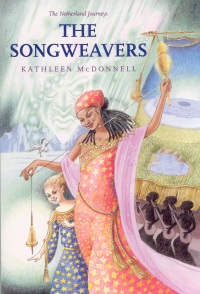| ________________
CM . . . . Volume XV Number 13. . . .February 20, 2009. 
 |
The Songweavers. (The Netherland Journeys).
Kathleen McDonnell.
Toronto, ON: Second Story Press, 2008.
195 pp., pbk., $9.95.
ISBN 978-1-897187-42-5.
Subject Headings:
Imaginary places-Juvenile fiction.
Quests (Expeditions)-Juvenile fiction.
Grades 8-10 / Ages 13-15.
Review by Janet M. Johnson.
**/4
|
| |
|

excerpt:
Without contraries, there will be no progression.” It was another of William Blake’s pronouncements that she remembered from her time with him. Now she felt that she finally understood its true meaning.
There was no running away from it. She would have to go back and weave the Nobodaddy into her Story Cloth.
“I will do whatever it takes to bring Notherland back, “she said in a halting voice. “But I still don’t understand. Why does there have to be evil in the world?”
The Songweavers, which is the third book in the Notherland journey series by Kathleen McDonnell, is a fantasy based in many interesting and imaginative worlds which the author describes as parocosms. The Songweavers is the story about a real girl named Peggy who invented Notherland at age seven in order to escape the turmoil of a home with an abusive father and her parents’ troubled marriage. Influenced by a book on the North Pole, she creates an imaginary world called Notherland which is populated by a tiny race of Nordlings.
This book is a different kind of fantasy as right from the beginning the reader knows it isn’t real. However, for its imaginary inhabitants, it does exist until its Creator, Peggy, starts to mature and is no longer mindful of its existence. In this, the third book in the series, Peggy is growing up and is infatuated with a young man, Jack Pine. This distraction causes her world to literally vanish and its inhabitants to disappear. One character, Molly, the pirate doll, becomes real again and finds herself on the floor of Peggy’s old house. Molly has returned to Peggy’s house in the real world to look for her creator and to try and save Notherland. However, saving the world is going to be up to Mi, one of the Nordlings, who will weave a story cloth and bring the world back as Molly is once more a doll and hasn’t the physical means to locate Peggy. Furthermore, another child now lives in Peggy’s house. Just like with Peggy, Molly again finds that she is a comfort to this new child who seems to have a troubled childhood.
There is another subplot involving a loon called Gavi who used to be a mental being but chose to be in the physical body of a loon and experience life on a physical plane. In Notherland he has mated and become a parent, himself, of a child with special abilities like himself.
McDonnell manages to develop these several strands of her story through skillful writing. Each character is well developed, and the reader develops sympathy for each of their stories. However, Mi’s adventures are interspersed with many philosophical discussions on the nature of good and evil and the balance of nature from a feminist perspective. Although the author, in her website, is looking to create a world for a strong female character, this does limit interest in the book to a feminine audience. The author’s intended audience is also widely spread, and this I also find limiting to an audience with more interest in the metaphysical than in pure adventure. The vocabulary and context of many of the words and ideas are not from a child’s perspective and would need the interpretation of an adult to get across a real understanding. With Peggy’s romantic interest and family problems, I feel the story is more suitable for adolescents than young children and would be a far more interesting read for girls than boys. The weavers, the Overseer, angels (from the first book) and the Mothers of Creation are all distinctly feminine images. This is a challenging novel for those children who appreciate different forms of literature and the interplay of symbols and imagery.
Recommended.
Janet M. Johnson is a librarian and instructor at Red River College in Winnipeg, MB.

To comment on this title or this review, send mail to
cm@umanitoba.ca.
Copyright © the Manitoba Library Association. Reproduction for personal use is permitted only if this copyright notice is maintained. Any other reproduction is prohibited without permission.
NEXT REVIEW |
TABLE OF CONTENTS FOR THIS ISSUE- February 20, 2009.
AUTHORS |
TITLES |
MEDIA REVIEWS |
PROFILES |
BACK ISSUES |
SEARCH |
CMARCHIVE |
HOME |
